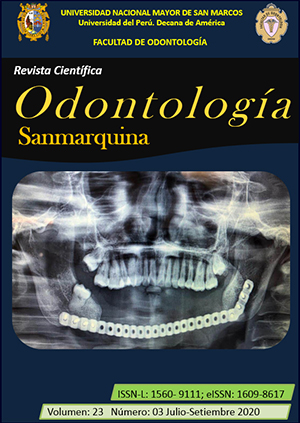Comparison of the transverse size of maxillary lateral incisors without microdontia
DOI:
https://doi.org/10.15381/os.v23i3.18127Keywords:
Tooth, Incisor, Prevalence, Malocclusion, (source: MeSH NLM)Abstract
Objective. To determine if there is a difference between the transverse sizes of the maxillary lateral incisors in the different Angle malocclusions and to determine the prevalence of maxillary lateral incisors with microdontia in the different Angle classes. Methods. The research is descriptive, transversal and observational. The study universe was 780 orthodontic pre-treatment study models. The sample was 190 study models. Binder and Cohen's method was used to determine the presence of microdontia. Results. In Class I malocclusion a frequency of microdontia of 32% was found, in Class II malocclusion it was 35% and in Class III malocclusion it was 26%. The upper lateral incisors with microdontia and without microdontia have a statistically different mean between them at a confidence level greater than 95%, this difference is observed homogeneously in each of the malocclusions. Conclusions. No statistically significant differences in the mesiodistal size of the maxillary lateral incisors were observed when comparing the three malocclusions described by Angle. A higher percentage of microdontia was obtained in Class II malocclusion, and a lower percentage in Class III.
Downloads
Downloads
Published
Issue
Section
License
Copyright (c) 2020 Alejandra Olivia Acosta-Pelayo, Jaime Fabián Gutiérrez-Rojo

This work is licensed under a Creative Commons Attribution-NonCommercial-ShareAlike 4.0 International License.
AUTHORS RETAIN THEIR RIGHTS:
a. Authors retain their trade mark rights and patent, and also on any process or procedure described in the article.
b. Authors retain their right to share, copy, distribute, perform and publicly communicate their article (eg, to place their article in an institutional repository or publish it in a book), with an acknowledgment of its initial publication in the Odontología Sanmarquina.
c. Authors retain theirs right to make a subsequent publication of their work, to use the article or any part thereof (eg a compilation of his papers, lecture notes, thesis, or a book), always indicating the source of publication (the originator of the work, journal, volume, number and date).






